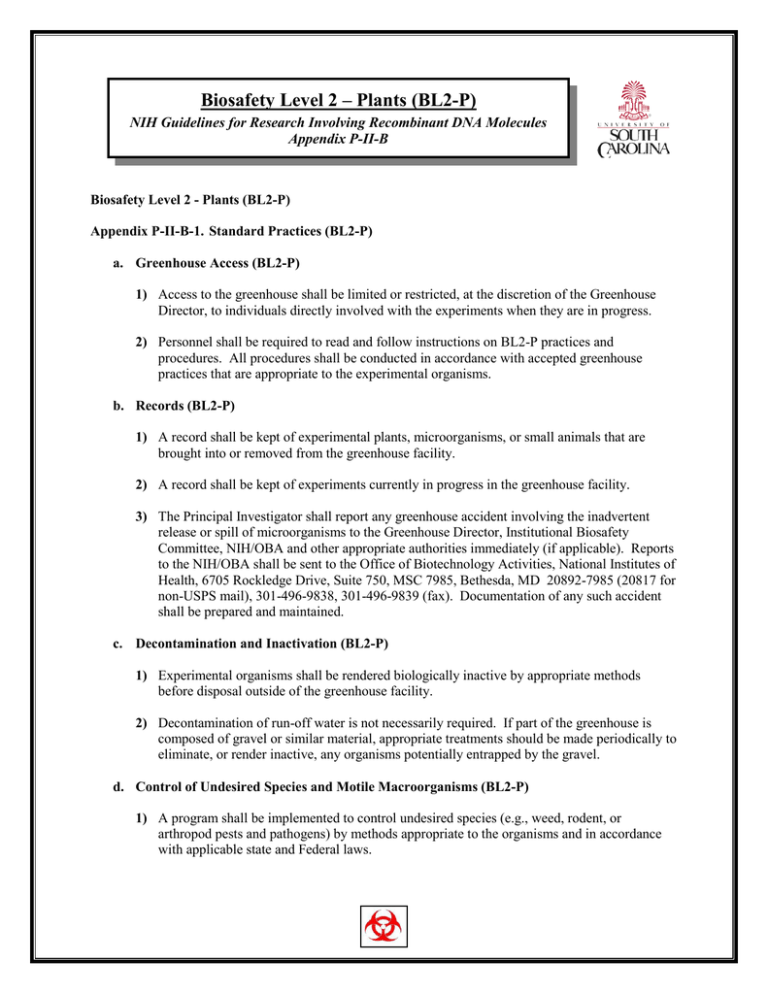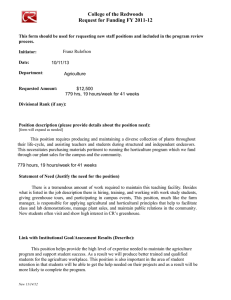Biosafety Level 2 – Plants (BL2-P) Appendix P-II-B
advertisement

Biosafety Level 2 – Plants (BL2-P) NIH Guidelines for Research Involving Recombinant DNA Molecules Appendix P-II-B Biosafety Level 2 - Plants (BL2-P) Appendix P-II-B-1. Standard Practices (BL2-P) a. Greenhouse Access (BL2-P) 1) Access to the greenhouse shall be limited or restricted, at the discretion of the Greenhouse Director, to individuals directly involved with the experiments when they are in progress. 2) Personnel shall be required to read and follow instructions on BL2-P practices and procedures. All procedures shall be conducted in accordance with accepted greenhouse practices that are appropriate to the experimental organisms. b. Records (BL2-P) 1) A record shall be kept of experimental plants, microorganisms, or small animals that are brought into or removed from the greenhouse facility. 2) A record shall be kept of experiments currently in progress in the greenhouse facility. 3) The Principal Investigator shall report any greenhouse accident involving the inadvertent release or spill of microorganisms to the Greenhouse Director, Institutional Biosafety Committee, NIH/OBA and other appropriate authorities immediately (if applicable). Reports to the NIH/OBA shall be sent to the Office of Biotechnology Activities, National Institutes of Health, 6705 Rockledge Drive, Suite 750, MSC 7985, Bethesda, MD 20892-7985 (20817 for non-USPS mail), 301-496-9838, 301-496-9839 (fax). Documentation of any such accident shall be prepared and maintained. c. Decontamination and Inactivation (BL2-P) 1) Experimental organisms shall be rendered biologically inactive by appropriate methods before disposal outside of the greenhouse facility. 2) Decontamination of run-off water is not necessarily required. If part of the greenhouse is composed of gravel or similar material, appropriate treatments should be made periodically to eliminate, or render inactive, any organisms potentially entrapped by the gravel. d. Control of Undesired Species and Motile Macroorganisms (BL2-P) 1) A program shall be implemented to control undesired species (e.g., weed, rodent, or arthropod pests and pathogens) by methods appropriate to the organisms and in accordance with applicable state and Federal laws. 2) Arthropods and other motile macroorganisms shall be housed in appropriate cages. If macroorganisms (e.g., flying arthropods or nematodes) are released within the greenhouse, precautions shall be taken to minimize escape from the greenhouse facility. e. Concurrent Experiments Conducted in the Greenhouse (BL2-P) 1) Experiments involving other organisms that require a containment level lower than BL2-P may be conducted in the greenhouse concurrently with experiments that require BL2-P containment provided that all work is conducted in accordance with BL2-P greenhouse practices. f. Signs (BL2-P) 1) A sign shall be posted indicating that a restricted experiment is in progress. The sign shall indicate the following: (i) the name of the responsible individual, (ii) the plants in use, and (iii) any special requirements for using the area. 2) If organisms are used that have a recognized potential for causing serious detrimental impacts on managed or natural ecosystems, their presence shall be indicated on a sign posted on the greenhouse access doors. 3) If there is a risk to human health, a sign shall be posted incorporating the universal biosafety symbol. g. Transfer of Materials (BL2-P) 1) Materials containing experimental microorganisms, which are brought into or removed from the greenhouse facility in a viable or intact state, shall be transferred in a closed nonbreakable container. h. Greenhouse Practices Manual (BL2-P) 1) A greenhouse practices manual shall be prepared or adopted. This manual shall: (i) advise personnel of the potential consequences if such practices are not followed, and (ii) outline contingency plans to be implemented in the event of the unintentional release of organisms. Appendix P-II-B-2. Facilities (BL2-P) a. Definitions (BL2-P) 1) The term "greenhouse" refers to a structure with walls, a roof, and a floor designed and used principally for growing plants in a controlled and protected environment. The walls and roof are usually constructed of transparent or translucent material to allow passage of sunlight for plant growth. 2) The term "greenhouse facility" includes the actual greenhouse rooms or compartments for growing plants, including all immediately contiguous hallways and head-house areas and is considered part of the confinement area. b. Greenhouse Design (BL2-P) 1) A greenhouse floor composed of an impervious material. Concrete is recommended, but gravel or other porous material under benches is acceptable unless propagules of experimental organisms are readily disseminated through soil. Soil beds are acceptable unless propagules of experimental organisms are readily disseminated through soil. 2) Windows and other openings in the walls and roof of the greenhouse facility may be open for ventilation as needed for proper operation and do not require any special barrier to exclude pollen or microorganisms; however, screens are required to exclude small flying animals (e.g., arthropods and birds). c. Autoclaves (BL2-P) 1) An autoclave shall be available for the treatment of contaminated greenhouse materials. d. Supply and Exhaust Air Ventilation Systems (BL2-P) 1) If intake fans are used, measures shall be taken to minimize the ingress of arthropods. Louvers or fans shall be constructed such that they can only be opened when the fan is in operation. e. Other (BL2-P) 1) BL2-P greenhouse containment requirements may be satisfied by using a growth chamber or growth room within a building provided that the external physical structure limits access and escape of microorganisms and macroorganisms in a manner that satisfies the intent of the foregoing clauses.




